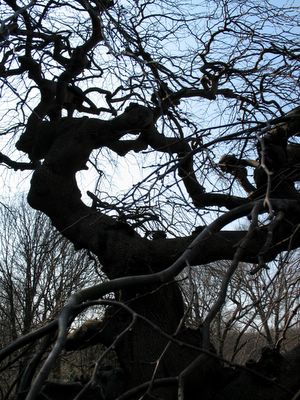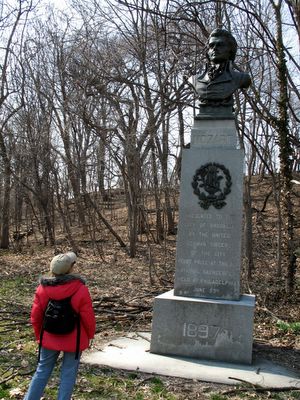Once upon a time, we were younger. That sounds comical, but living near the park as we do now is a deja vu of an another time (before children) when we lived in an apartment on Hawthorne Street. We would walk almost daily to Prospect Park, just a few blocks away and while away the hours, hanging with friends, playing with our dogs, just breathing in the natural beauty that lay on our doorstep.
And so, today, we went for a long walk in Prospect Park on what was a beautiful, almost early spring day. Spring doesn't arrive officially for two more days but the temperature is hovering just under 50, the sky is blue, the sun is shining, the birds are singing and that marvelous scent of spring is in the air.
We decided to follow the path that follows Long Meadow, a vast and beautiful field running south from Grand Army Plaza at the north end of the park. During warm months, this place is teeming with people, sitting and lying, playing ball or just playing. Now, despite the warming trend, it was mostly empty. It's still a weekday at the end of winter so people are not in their park mode yet.
At one point the path cuts across the meadow from west to east and then heads south again. We found ourself at the entrance to a gated section of the park with a sign announcing that we were about to enter The Ravine. The gate was open and we entered a quiet and peaceful vale. The Ravine is the source of the water that flows and fills the various ponds, creeks and, finally, the lake at the south end of the lake. When the park was built by Olmstead and Vaux in the 1870's, part of the construction included wells and a reservoir to supply the water for the streams and ponds that would give parkgoers an appearance of natural beauty despite their manmade origins.
We followed the path to its end and found ourselves in a place that we knew so well from many years ago. The Nethermead is another of the park's meadows and it's where we would park ourselves while our two dogs would enjoy the run of the lawn and the surrounding hills. Next to the Nethermead is the lovely and peaceful Lullwater, a serpentine stream that connects the Pools, two small ponds just above the Ravine, to the Lake at the south end of the park. On occasion, and much to our consternation, the dogs would jump into the water to cool off in the heat of summer.
A lot of improvements have been made to the park after the terrible deterioration of the 1970's when the city's economy plummeted. The Boathouse has been totally renovated and is a spectacular gleaming white neo-classical building, sitting astride the Lullwater. We passed over Lullwater bridge and then realized that we were at the site of the famous, 133-year old Camperdown Elm, an old friend of ours from the 1970's. We were so happy to see that it was still there, after all these years, and still alive. It was planted in 1872 next to the Boat House and is considered the outstanding specimen tree in all of Prospect Park.

The 133 year old Camperdown Elm.

Prospect Park's most famous tree, born in 1872.
We left the Nethermead and Boathouse area via the Cleft Ridge tunnel. Now we were in the Music Grove. Here, in the late 19th century and into the early 20th, outdoor concerts were performed. It's hard to imagine how grand and elegant this must have been. Various musical societies competed and statues of famous composers adorn this garden, given as gifts to the "city of Brooklyn" (Brooklyn was its own city until incorporated into New York in 1898).

A detail from the entrance wall to Music grove.

Amadeus (and Stacey).

Here's old Ludvig. " Presented to the City Of Brooklyn in 1894 by United German Singers of the City."
A few steps down from the Music Grove is a beautiful plaza surrounded by giant London Plane trees. Here was a statue of Abraham Lincoln with two plaques: "USA" on the back, "USN", on the front. No other explanation. We wondered why and how and what the Navy designation meant on this particular statue of the great president.

Here's Abe with a U.S. Navy plaque and no other explanation.
We walked back north and to the exit at Grand Army Plaza. We passed the Carousel, the old Lefferts homestead and the zoo. As we neared the exit, we stopped to admire dozens and dozens of newly-bloomed crocuses and snow bells that had survived the last few snowfalls and bitterly cold weather. This was the affirmation that spring, indeed, had arrived.

You light up my life....early crocuses above Long Meadow.
No comments:
Post a Comment